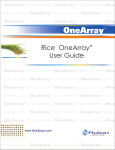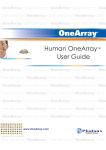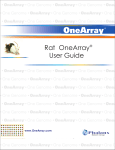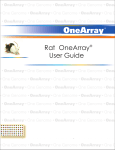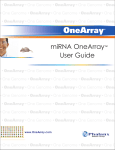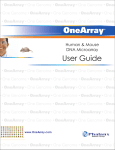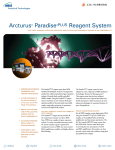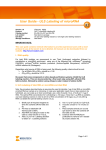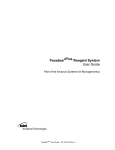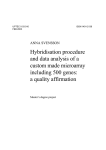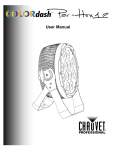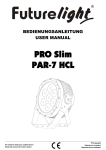Download Getting Started
Transcript
Mouse OneArray® V2.1 User Guide ww www.OneArray.com Notice to the User IMPORTANT! It is important that users read the entire manual before commencing work. Phalanx Biotech Group Mouse OneArray User Guide v2.1a i Warranty and Liability Phalanx Biotech Group’s products are intended for research use only, and not intended for any other uses. OneArray® microarray products are designed and manufactured for research use only. Buyers and users agree and understand that they are not granted the right to use OneArray® products for clinical diagnostic purposes unless they obtain written approval from the appropriate government authority. Phalanx Biotech Group (Phalanx Biotech) will not be liable for any damages arising from the use of its products in any manner other than their intended use or for the use of its products for clinical diagnostic purposes without written approval from the appropriate government authority. The manufacture, sale, or importation of products from Phalanx Biotech is not permitted without the prior written consent from Phalanx Biotech. Buyers and users agree and acknowledge that Phalanx Biotech is the owner and has the copyrights to the probe sequence information of the Mouse OneArray® product, and any other OneArray® products. Phalanx Biotech is founded on the mission to offer researchers high-quality and user-friendly solutions at an affordable price. Your satisfaction in using our products is very important to us. Therefore, if any of our products is not performing to the standard we promised, we are willing to replace the product, or credit the product purchase price. Phalanx Biotech accepts liability of ONLY the purchase price of its products, and has no other liabilities. ii Mouse OneArray User Guide v2.1a Phalanx Biotech Group Contact Information Asia Office Phalanx Biotech Group th 6 Technology Road 5, 6 Floor Hsinchu Science Park Hsinchu 30078, Taiwan Tel: 886-3-578-1168 Toll-Free: 0800-777-988 FAX: 886-3-578-5099 E-mail: [email protected] website: www.onearray.com China Office Phalanx Biotech Group E-mail: [email protected] website: www.onearray.com.cn Toll-Free: 4006-4008-60 U.S. Office Phalanx Biotech Group 1301 Shoreway Road, Suite 160 Belmont, CA, USA, 94002 Tel: 650-320-8669 Toll-Free: 877-730-3887 FAX: 650-508-9889 E-mail: [email protected] website: www.phalanxbiotech.com www.onearray.com Phalanx Biotech Group Mouse OneArray User Guide v2.1a iii User Guide and Technical Support Electronic version of this manual is available on the enclosed Product Support CD, and online at: www.onearray.com To reach technical support by telephone, call Within the US: 650-320-8669 Outside the US: 886-3-5781168 Feedback We welcome your feedback regarding our products and this manual. Please contact us at: [email protected] All comments are welcome. iv Mouse OneArray User Guide v2.1a Phalanx Biotech Group Trademarks and Copyrights ® ® Mouse OneArray , and OneArray are trademarks of Phalanx Biotech Group, Inc. in the United States and in other countries. All trademarks and copyrights used in this manual belong to their respective owners and are the sole property of their respective owners. CyDye™ and Cy™ are trademarks of GE Healthcare. AlphaScan™® is a trademark of Alpha Innotech, Inc. ArrayWoRx Biochip Reader is a registered trademark ® of Applied Precision , Inc. GenePix™ is a trademark of Molecular Devices. ® GeneTAC™ is a trademark of Genomic Solutions®, Inc. ScanArray™ 5000 is a trademark of Perkin Elmer , Inc. mSerries ®LifterSlip™ is a trademark of Erie Scientific Company . Amino Allyl MessageAmp™ II aRNA is a trademark of ® Ambion . ® ArrayControl™ is a trademark of Ambion , Inc. SpotReport is a registered trademark of Strategene, Inc. BioMicro® and Maui® are registered trademarks of BioMicro Systems, Inc. ULS™ is a trademark of Kreatech Diagnostics. NanoDrop™ is a trademark of Thermo Fisher Scientific. Last updated Nov 2012 © 2005 - 2012Phalanx Biotech Group. All rights reserved. Phalanx Biotech Group Mouse OneArray User Guide v2.1a v Thank You Phalanx Biotech Group would like to extend special thanks to our customers who have provided feedback that enabled us to improve the Mouse OneArray® User Guide. vi Mouse OneArray User Manual v2.1a Phalanx Biotech Group Mouse OneArray® User Guide Notice to the User ............................................................................. i Thank You ...................................................................................... vi Mouse OneArray® ......................................................................... vii Getting Started ................................................................................ 1 Product Contents -------------------------------------------------------------------------- 1 Other Necessary Apparatus (Not Supplied) ----------------------------------------- 2 Other Necessary Reagents (Not Supplied) ------------------------------------------- 3 Important Notes on Microarray Handling and Storage--------------------------- 4 Product Descriptions and Overview --------------------------------------------------- 5 Using Mouse OneArray® ---------------------------------------------------------------- 7 Step 1 Prepare the RNA Sample ----------------------------------------------------- 8 Step 2 Label the Target ---------------------------------------------------------------- 9 Step 3 Pre-Hybridize the Microarray -------------------------------------------- 11 Complete the Hybridization Protocol ----------------------------------------------- 13 Step 5 Wash the Hybridized Microarray ---------------------------------------- 28 Scan and Extract Gene Expression Results ---------------------------------------- 29 Step 7 Check the Control Probe Data -------------------------------------------- 32 OneArray® Product Family.......................................................... 33 Phalanx Biotech Group Mouse OneArray User Guide v2.1a vii Getting Started Please read the introductory information below to help familiarize yourself with Mouse OneArray® before use. Product Contents Mouse OneArray® DNA Microarray OneArray® Hybridization Buffer Tube • Each tube contains buffers sufficient for 50 microarray hybridization procedures Spare round cap tube Mouse OneArray® User Guide Spotted Region Guide Product Support CD, which contains the following: • Sample Images • Mouse OneArray.gal file • Mouse OneArray® gene list and probe sequences • Mouse OneArray® microarray layout • Mouse OneArray® Control Probe list • Mouse OneArray® User Guide (electronic version) Phalanx Biotech Group Mouse OneArray User Guide v2.1a 1 Other Necessary Apparatus (Not Supplied) Apparatus • Water bath/heating block • Powder-free gloves • Clean, blunt forceps • Micropipettors • Sterilized and nuclease-free pipet tips • Sterilized and nuclease-free microcentrifuge tubes • High-speed microcentrifuge • Low-speed tabletop microcentrifuge with slide holder attachment • Vortex mixer • Hybridization oven • Hybridization accessories: chamber cover slides, etc. • Rectangular slide staining dish and slide rack for washing microarrays • PCR (polymerase chain reaction) machine • Microarray scanner for standard 1” x 3” format (see Table 6 under “OneArray® Microarray Scanner Specifications” for a list of compatible scanners) • Hybridization systems (optional) • Automated hybridization station (optional) 2 Mouse OneArray User Manual v2.1a Phalanx Biotech Group Other Necessary Reagents (Not Supplied) Reagents De-ionized nuclease-free water Cyanine 3- or 5-labeled amplified aRNA sample 20x SSC stock solution, sterile filtered: o 3.0 M Sodium chloride o 0.3 M Sodium phosphate (pH 7.0) 20x SSPE stock solution, sterile filtered: o 3.6 M Sodium chloride o 0.2 M Sodium phosphate (pH 7.7) o 20 mM EDTA Wash Solutions, sterile filtered (approximately 250mL of each is required per experiment): o 2 x SSC, 0.2% SDS o 2 x SSC o 0.2 x SSC NOTE: SDS must be molecular biology grade. Pre-hybridization Buffer, prepared and sterile filtered immediately prior to pre-hybridization: o 5x SSPE, 0.1% SDS, 1% BSA NOTE: BSA must be molecular biology grade. Deionized formamide to be added to the OneArray® Hybridization Buffer prior to use (see Step 4). RNA Fragmentation Reagent and Stop Solution (for hybridization using aRNA) DNA Blocking Mixture: o Ambion® sheared Salmon Sperm DNA (10 µg/µL), or Invitrogen™ Cot-1 DNA® (2.5 µg/µL), or Invitrogen™ Poly-A (2.5 µg/µL) Phalanx Biotech Group Mouse OneArray User Guide v2.1a 3 Important Notes on Microarray Handling and Storage Storage Conditions OneArray® chip can be stored at room temperature for several weeks. For Long-term storage, please keep it at 2-8 °C. Store OneArray® temperature. Hybridization Buffer at room NOTE: If the product is received with an open bag, please contact Phalanx Biotech Customer Service for an immediate replacement. Handling Microarrays IMPORTANT! Please read this section carefully and follow the instructions! Polynucleotide probes are printed on the side of the slide with the barcode. To avoid irreparable damage of the printing area, do not touch the surface with bare hands, or with any other objects. Whenever possible, handle microarrays with clean blunt forceps to avoid contamination. IMPORTANT! 4 Opened arrays should be used within a week. Mouse OneArray User Manual v2.1a Phalanx Biotech Group Product Descriptions and Overview Mouse OneArray® Whole Genome DNA microarrays are made of sense-strand polynucleotide probes spotted onto a proprietary chemical layer coated on top of a 1” x 3” (25 mm x 75 mm) standard-format microarray glass slide. Updated information of genome content from public domains is used to design approximately 27,000 highly sensitive long-oligonucleotide probes for monitoring the expression level of corresponding proteincoding genes. Each probe is spotted onto the array in a highly consistent manner using a proprietary, non-contact spotting technology adapted for microarray manufacturing. Mouse OneArray® v2.1 Genome Content Each microarray contains 27,307 oligonucleotides: 26,423 mouse genome probes, and 884 experimental control probes. Mouse oligonucleotide probe is designed to hybridize to a specific target gene described in the current public domain contents, such as NCBI Reference Sequence (RefSeq) Database and Ensembl database. Table 1, below, provides an example of the contents of a mouse genome that can be studied using the Mouse OneArray® v2.1. Table 1: Mouse OneArray® v2.1 probe Content Probe Type MOA 2.1 probes New Probes Design based on: -RefSeq release 42 -Ensembl release 59 Control Probes Number of Probes 27,307 (total)* 26,423 884 * Mouse OneArray® is guaranteed to contain > 98% of the total probe content. Phalanx Biotech Group Mouse OneArray User Guide v2.1a 5 Mouse OneArray® v2.1 Control Features There are 884 control probes built into the Mouse OneArray® DNA microarray that monitor the sample quality and hybridization process. These control probes provide valuable information to ensure experiments are done correctly to ensure higher quality results for analysis. NOTE: Detailed control information, gene lists, gene annotations, and probe sequences can be found on the Product Support CD that accompanied this product, or at: http://www.onearray.com 6 Mouse OneArray User Manual v2.1a Phalanx Biotech Group Using Mouse OneArray® This section provides you with detailed information about how to perform the steps necessary to complete the hybridization process to study gene expressions using the Mouse OneArray® microarray. IMPORTANT! Follow these detailed steps exactly to achieve the best experimentation results. Step 1: Prepare the RNA Sample Step 2: Label the Target Step 3: Pre-Hybridize the Microarray Step 4: Perform the Hybridization Protocol Step 5: Wash the Hybridized Microarray Step 6: Scan and Extract Gene Expression Results Step 7: Check Control Probe Data Phalanx Biotech Group Mouse OneArray User Guide v2.1a 7 Step Step1:1 IMPORTANT! Prepare the RNA Sample High-quality, intact RNA is essential for all gene expression microarray experiments. There are many different RNA isolation protocols and commercially available RNA isolation kits. You should choose a solution that meets your specific needs. Qiagen, Ambion, Invitrogen and other reagent companies offer many different RNA isolation products. For more information, you can visit each company’s website. Once the RNA samples are isolated, you must confirm the quantity and quality of the samples. Similarly, many different protocols are available and you should choose a solution that is suitable for your needs. For faster and more automated RNA analysis, you may want to TM consider the “No Cuvettes” Spectrophotometer from NanoDrop , or the 2100 Bioanalyzer from Agilent Technologies. For more information, visit each company’s website. 8 Mouse OneArray User Manual v2.1a Phalanx Biotech Group Step Step2:2 IMPORTANT! Label the Target For best results, it is recommended that you use one of the commercially available labeling kits that has been tested for use with the Mouse OneArray® microarray—please refer to Tables 2 below. General Guidelines for Target Labeling There are many commercially available labeling kits for microarray analysis. Select a labeling kit or labeling method that is most suitable for your specific needs. If you use a labeling kit that is not listed in Tables 2, it is recommended that you validate the method to test and determine its compatibility with the Mouse OneArray®. You may want to confirm the quality of the labeled target with the TM “No Cuvettes” Spectrophotometer from NanoDrop . RNA Sample Amounts Generally, the amount needed of quality RNA is 10 µg for each labeling reaction. If you have an ample supply of RNA samples, you have the choice of using a protocol that either amplifies or does not amplify the RNA sample. If you have a limited amount of RNA samples, it is recommended that you use a protocol that includes a linear amplification of the RNA samples. Dye Incorporation Efficiency Good dye incorporation rates are important for yielding the best data from microarray hybridization. Incorporation rates of 20-60 dye molecules per 1000 bases (17-33 bases / dye molecule) yield the most usable data. Rates below 20 dyes per 1000 bases (50 bases / dye) are very low and may lead to a loss of signal of many targets. It is not recommended to perform hybridization with samples of low dye incorporation efficiency. Phalanx Biotech Group Mouse OneArray User Guide v2.1a 9 For aRNA Hybridization Follow the instructions provided by the reagent supplier. Indirect labeling with NHS ester dye is recommended. Table 2, below, contains a list of products that have been tested for use with OneArray®. Table 2: aRNA Preparation Products Manufacturer Product Name and Description Ambion® Amino Allyl MessageAmp II™ aRNA Kit Ambion® aRNA Fragmentation Reagent Epicentre® Biotechnologies TargetAmp™ 1-Round Aminoallyl -aRNA Amplification Kit For aRNA labeling, 10 μg of quality aRNA is recommended. Smaller volumes can lead to significant loss of sample and may increase the concentration of contaminants in the labeled aRNA sample, leading to higher background signal. It is best to use aRNA as soon as possible after labeling, as exposure to air and light can reduce the signal of some dyes. If it must be left overnight, it is best to aliquot your labeled aRNA and store in the dark at -80°C. Avoid thawing and re-freezing aRNA if possible, as freeze-thaw cycles can damage the aRNA. Finally, aRNA fragmentation is best performed immediately prior to hybridization (Step 4). 10 Mouse OneArray User Manual v2.1a Phalanx Biotech Group Step Step3:3 Pre-Hybridize the Microarray General Instructions IMPORTANT! Mouse OneArray® requires a pre-hybridization step prior to hybridization of the labeled target. The pre-hybridization step reduces background signals and increases the performance of the microarray. Complete the pre-hybridization step by carefully following the instructions below. 1) Warm the pre-hybridization solution (5x SSPE, 0.1% SDS, and 1% BSA) to 42°C. 2) Pour 25 ml room temperature 100% ethanol into the spare array tube. 3) Preheat the Mouse OneArray®(s) in the round cap tube at 60°C for 10 min (hybridization oven recommended). 4) Remove the Mouse OneArray®(s) from the round cap tube, place in the two outermost slots inside the tube containing 100% ethanol, close the cap, and let sit for approximately 15 sec. 5) Shake the round cap tube for 20 sec. 6) Remove and thoroughly rinse each array with deionized water to remove any residual ethanol. 7) Carefully and slowly, fully submerge the Mouse OneArray® in a sufficient amount of pre-hybridization solution for 1 hr at 42°C (35 ml is sufficient if using a round cap tube). Phalanx Biotech Group Mouse OneArray User Guide v2.1a 11 IMPORTANT! Try to insert the slides into the correct position the first time. Avoid inserting and removing the slides more than once in the pre-hybridization buffer. 8) After 1 hr, transfer the slide(s) to room temperature, distilled water and wash gently for 2 min. 9) Spin dry the slide(s) for 2 min. Store in a dry, dark place until hybridization. It is recommended that you use the slides in the hybridization protocol within 1 hr of completing the pre-hybridization process. 12 Mouse OneArray User Manual v2.1a Phalanx Biotech Group Step 4: Complete the Hybridization Protocol Once you have completed the pre-hybridization step using the method outlined in the Step 3: Pre-Hybridize the Microarray section, you are ready to complete the hybridization protocol. There are many different hybridization protocols, apparatus, and instruments available that may be compatible for use with the OneArray® microarray. Detailed instructions for using the glass cover slide method are described below. For best performance and consistent hybridization results, it is recommended that you use the OneArray® Hybridization Buffer, included with this product to complete the hybridization process. A. Using the Phalanx hybridization system Step 4Aa: Prepare Hybridization Solution Using the OneArray® Hybridization Buffer (Included) IMPORTANT! For correct use of this buffer, you must add a specific amount of formamide and labeled target. Please follow the instructions below carefully. Phalanx Biotech Group 1) Spin down the stock OneArray® Hybridization Buffer (~ 5.5 ml in each tube). 2) Add 4.5 ml of deionized formamide. 3) Warm the mixture to 42 oC to completely dissolve the solution. Mix thoroughly. Yield: 10 ml of 1.5x Hybridization Buffer solution. 4) Make up 1x Hybridization Buffer by adding nucleasefree H2O. 5) Aliquot the solution into individual tubes according to usage and store in darkness at -20 oC. Mouse OneArray User Guide v2.1a 13 Step 4Ab: Prepare Target for Hybridization Hybridization Using Labeled Targets from aRNA Labeling Approaches 1) Mix 10 µg of your aRNA sample with nuclease-free H2O to yield a final volume of 27 µL. NOTE: It is essential to use at least 10 µg of labeled target for each hybridization. If you are performing a dual-dye experiment, use at least 10 μg of each labeled aRNA sample. 2) Add 3 µL 10x Fragmentation Reagent, and incubate at 70oC for 15 minutes. 3) Add 3 µL Stop Solution, and mix well. 4) Mix with nuclease-free H2O to yield a final volume of 60 µL. 5) Keep on ice and in darkness until hybridization (Step 4Ac). Step 4Ac: Complete the Hybridization 1) Thaw and re-suspend the 1.5x and 1x Working Hybridization buffer at 42~65 oC for 10 minutes. 2) Preheat water bath to 95 oC. The water batch should be sufficient to submerge a microarray slide vertically, i.e. large beaker. 3) Prepare Target Hybridization Mix: 14 Mouse OneArray User Manual v2.1a Phalanx Biotech Group Final Total Volume of Target Hybridization Mix 180 μL Labeled target mix 60 μL 1.5x Working Hybridization Buffer Add RNAase free ddH2O to reach the final volume 120 μL NOTE: Different volumes of labeled target mix may be obtained due to different labeling protocols. If the final volume of the labeling target mix is insufficient, use distilled water to make up the volume. 4) Denature the Target Hybridization Mix from the previous step in a PCR machine at 95 oC for 5 minutes and hold at 60 oC. 5) Assembling Process: i. Phalanx Biotech Group Take cover slide out from the package. Mouse OneArray User Guide v2.1a 15 ii. Carefully laid the Mouse OneArray® on top of the assembly of cover slide and spacer, where the printed side of array should be facing toward the cover slide, to form a hybridization assembly. The printed side of array is on the side of the label iii. Insert the hybridization assembly into a (3.1 x 9cm) heat-shrank hybridization (Hyb.) bag. Sample loading side of the hybridization assembly should face the opening side of film bag. Lower the assembly to the end of the bag (Assembly viewed from the other side). iv. Clip the bag with a clipper “securely” from the opening end. Immerse the assembly to the rim of the slide in 95oC hot water swiftly (approximately 2~5 sec). Do not dip the assembly too far into the water to avoid water leaking into the assembly. The Hyb. bag will shrink and tightly wrap around the assembly. Caution: Hot water bath is >90oC! Do not dip your hand into the water! 16 Mouse OneArray User Manual v2.1a Phalanx Biotech Group 3mm v. Remove the assembly from water and wipe off the water from the assembly. Trim off the excess film from the top of the assembly. Keep the assembly in a 50oC oven for at least 10 minutes vi. Load the entire target hybridization mix into the assembly through the sample loading opening. Add 60 uL of 1x hybridization buffer and leave approximately 3mm (0.3cm) of space from the top rim. Caution: Tilt the assembly slightly for easier loading. vii. Cut the second Hyb. Bag to approximately onehalf of its original length. Phalanx Biotech Group Mouse OneArray User Guide v2.1a 17 viii. Keep the assembly vertical and slip on the shortened Hyb. bag from step viii all the way until the assembly reaches the end of the Hyb. bag. ix. Use a pair of forceps to hold onto the top of the assembly. Immerse the entire assembly into 95oC hot water with the assembly in upright position. Caution: Make sure a bubble forms in the closed hybridization system. If the bubble does not appear or appears to be much smaller, please try to tap on the slide slightly to disturb the mixture into forming a bubble. Also, make certain that all the air bubbles in the mixture eventually mix into one big bubble. x. Place the hybridization assembly into a 50oC oven and set it on a rotator. Remember to rotate the assembly at 2 rotations per minute (RPM) for overnight. Note: Please check to see that the bubble rotates and move freely in the solution to aid in the mixing effect during hybridization. 18 Mouse OneArray User Manual v2.1a Phalanx Biotech Group B. Using OneArray™ Full Length Chamber Step 4Ba: IMPORTANT! Prepare Hybridization Solution Using the OneArray® Hybridization Buffer (Included) For correct use of this buffer, you must add a specific amount of formamide and labeled target. Please follow the instructions below carefully. 1) Spin down the stock OneArray® Hybridization Buffer (~ 5.5 ml in each tube). 2) Add 4.5 ml of deionized formamide. 3) Warm the mixture to 42 oC to completely dissolve the solution. Mix thoroughly. Yield: 10 ml of 1.5x Hybridization Buffer solution. 4) Make up 1x Hybridization Buffer by adding nuclease-free H2O. 5) Aliquot the solution into individual tubes according to usage and store in darkness at -20 oC. Step 4Bb: Prepare Target for Hybridization Hybridization Using Labeled Targets from aRNA Labeling Approaches 1) Mix 10 µg of your aRNA sample with nuclease-free H2O to yield a final volume of 27 µL. NOTE: It is essential to use at least 10 µg of labeled target for each hybridization. If you are performing a dual-dye experiment, use at least 10 μg of each labeled aRNA sample. Phalanx Biotech Group Mouse OneArray User Guide v2.1a 19 2) Add 3 µL 10x Fragmentation Reagent, and incubate at 70oC for 15 minutes. 3) Add 3 µL Stop Solution, and mix well. 4) Mix with nuclease-free H2O to yield a final volume of 67 µL. 5) Keep on ice and in darkness until hybridization (Step 4Bc). Step 4Bc: Complete the Hybridization 1) Thaw and re-suspend the 1.5x and 1X Working Hybridization buffer at 42~65 oC for 10 minutes. 2) Preheat water bath to 95 oC. The water batch should be sufficient to submerge a microarray slide vertically, i.e. large beaker. 3) Prepare Target Hybridization Mix: Final Total Volume of Target Hybridization Mix 200 μL Labeled target mix 67 μL 1.5x Working Hybridization Buffer Add RNAase free ddH2O to reach the final volume 133 μL NOTE: Different volumes of labeled target mix may be obtained due to different labeling protocols. If the final volume of the labeling target mix is less, use distilled water to make up the volume. 20 Mouse OneArray User Manual v2.1a Phalanx Biotech Group 4) Denature the Target Hybridization Mix from the previous step in a PCR machine at 95 oC for 5 minutes and hold at 60 oC. 5) Assembling Process: Phalanx Biotech Group i. Remove the clear liner on the back of the hybridization chamber. Align the tab-end of the chamber to the edge of the microarray opposite to the barcode. It is easier to hold the long edges of the chamber in one hand and press down the tab with the other hand.(Figure 1) ii. Use the applicator stick provided to press along the adhesive areas to ensure a secure seal. Visually inspect the seal from underneath the microarray; inconsistent patterns in the black adhesive may indicate an insecure seal. Re-use the applicator stick if needed (Figure 2) iii. Allow the adhesive to set for 30 minutes iv. Pipette 200 μL of the labeled RNA solution through one port of the chamber while allowing air to escape through the other port. Make sure there are no bubbles in the pipette tip. If air bubbles form within the chamber, light pressure may be applied to the surface to dislodge them. (Figure 3) v. Wipe excess solution from the ports. Be careful not to draw solution from the chamber. vi. Cover ports with supplied circular seals. Seals should be removed from the liner and applied using forceps. The seals will adhere to most wet surfaces. Apply pressure to both seals simultaneously to ensure a secure adhesion. (Figure 4) Mouse OneArray User Guide v2.1a 21 22 vii. Keep the chamber/microarray assembly at 50 °C for 14-16 hrs. Rotation of the assembly during hybridization has been shown to increase the signal intensity viii. Prepare the first wash solution of 2x SSC, 0.2 % SDS and warm to 42 °C. More details can be found in the OneArrayTM Microarray User Guide. ix. Remove the chamber/microarray assembly from the hybridization oven and completely submerge it under the wash solution. Use forceps to slowly lift and remove the chamber starting from the tab-end. Use the holes in the tab for a better grip. Be sure to keep the microarray under the wash solution during removal. (Figure 5) x. Wash the array in the solution, and proceed to follow the remaining steps according to the step 5. Mouse OneArray User Manual v2.1a Phalanx Biotech Group C: Hybridization Using the Glass Cover Slide Method Step 4Ca: Prepare Hybridization Solution Using the OneArray® Hybridization Buffer (Included) IMPORTANT! For correct use of this buffer, you must add a specific amount of formamide and labeled target. Please follow the instructions below carefully. 1) Spin down the stock OneArray® Hybridization Buffer (~ 5.5 ml in each tube). 2) Add 4.5 ml of deionized formamide. 3) Warm the mixture to 42 °C to completely dissolve the solution. Mix thoroughly. Yield: 10 ml of 1.5x Hybridization Buffer solution. 4) Make up 1x Hybridization Buffer by adding nucleasefree H2O. 5) Aliquot the solution into individual tubes according to usage and store in darkness at -20 °C. Step 4Cb: Prepare Target for Hybridization Hybridization Using Labeled Targets from aRNA Labeling Approaches 1) Mix 2 µg of your aRNA sample with nuclease-free H2O to yield a final volume of 9 µL. NOTE: It is essential to use at least 2 µg of labeled target for each hybridization. If you are performing a dual-dye experiment, use at least 2 µg of each labeled aRNA sample. 2) Add 1 µL 10x Fragmentation Reagent, and incubate at 70 °C for 15 minutes. Phalanx Biotech Group Mouse OneArray User Guide v2.1a 23 3) Add 1 µL Stop Solution, and mix well. 4) Mix with nuclease-free H2O to yield a final volume of 17 µL. 5) Keep on ice and in darkness until hybridization (Step 4Bc). Step 4Cc: Complete the Hybridization NOTE: If you perform hybridization using methods other than the basic glass cover slide method, it is recommended that you validate the protocol experimentally. For example, the phalanx hybridization system, the MAUI System from BioMicro Systems, or HS Series of Hybridization Stations from TECAN offer a higher throughput and more automated hybridization methods. To complete this step, you will need to select a type of glass cover slide. Table 3, below, contains a list of glass cover slides that have been tested and confirmed compatible for use with the OneArray® Buffer. Table 3: Compatible Glass Cover Slide Products Manufacturer Product Name BioRad® Laboratories SLS 6001 (24x60 mm) Erie Scientific Company® mSeries LifterSlip™ 25x601-M-5439 Corning® Cover Glass (24 x 60 mm) 1) Ensure your work and experimentation area, as well as the OneArray®, are clean before adding the Hybridization Buffer solution to the target array. 2) Pre-warm the Hybridization Buffer with formamide at 42°C for 10 minutes. 3) Prepare the hybridization mix in a 1.5 ml Eppendorf tube according to the Table 4, below. 24 Mouse OneArray User Manual v2.1a Phalanx Biotech Group Table 4: Hybridization Mix Measurements For each slide: 55 µL Component Final Volume 1.5x OneArray Hybridization Buffer 37 µL Sheared Salmon Sperm DNA (10 µg/µL)* 1 µL Target preparation plus nuclease-free ddH2O 17 µL ® * Alternatives to Salmon Sperm DNA Blocking Mixtures: Ambion® sheared Salmon Sperm DNA (10 µg/µL), or Invitrogen™ Cot-1 DNA® (2.5 µg/µL), or Invitrogen™ Poly-A (2.5 µg/µL) 4) Spin down the mixture for 5 minutes to eliminate potential debris. 5) Transfer the mixture to a new tube. 6) Heat the mixture to 95°C for 5 minutes (thermocycler recommended). 7) Maintain the mixture at a temperature of 60°C until pipetting onto the array (thermocycler recommended 1). 8) Place the OneArray® slide, bar code up, atop the “Probe Printed Region Guide” (included, see Figure 1). 1 It may be helpful to set a Denature program in the thermocycler as follows: 95°C – 5 minutes 60°C – Hold Phalanx Biotech Group Mouse OneArray User Guide v2.1a 25 Figure 1: OneArray® Microarray Glass Slide with “Probe Printed Region Guide” Plastic Underlay. 9) Pipette the hybridization mixture onto the spotted region of OneArray® DNA Microarray. Avoid creating any bubbles. 10) Carefully place the glass cover slide over the spotted area in an even manner. 11) Place the entire labeled target plus the microarray set-up into a closable, chambered box* that is humidified by 2x SSPE buffer in the 50°C oven for 14 to 16 hours. A sealed chamber ensures that the appropriate humidity level is maintained during incubation. (See Figure 2). 26 Mouse OneArray User Manual v2.1a Phalanx Biotech Group Figure 2, below, provides an illustration of Step 4Bc, where the hybridization protocol is completed using the glass cover slide method, and specifically, the OneArray® DNA Microarray is placed into the chambered box. Place the hybridized microarray slide on top of the filled chambers inside the box, and close the box. Figure 2: Step 4Bc aRNA Hybridization—Glass Slide Inside Chamber Box2 2 The Hinged 100-Place Storage & Freezer Polypropylene Box from USA Scientific has been used to complete this step with frequent success. The small (approximately ½ inch x ½ inch) chambers within the box are filled about ¾ full of buffer, then the microarrays are laid on top of the chambers. The box is then closed and placed inside the oven. For information about this product or other USA Scientific products, access their Web site at: www.usasciesntific.com Phalanx Biotech Group Mouse OneArray User Guide v2.1a 27 Step Step5:5 IMPORTANT! Wash the Hybridized Microarray Washed and dried microarrays should be scanned within a couple of hours. NOTE: Do not allow the microarray(s) to be exposed to air for a significant amount of time; otherwise, an increased fluorescent background signal could appear. 1) Submerge the entire labeled target and microarray set-up with the cover slide still intact into a large container filled with 42°C 2x SSC, 0.2% SDS solution. 2) Carefully remove the cover slide from the glass by gently shaking the glass slide so that the cover slide is freed while the slide is submerged. NOTE: At this stage, the microarray has the highest concentration of unhybridized target and dye. Transfer the array quickly to the slide rack to minimize exposure to air. 3) Wash the slide(s) in the “rectangular, slide staining dish and slide rack” with the excess amount of pre-warmed 2x SSC, 0.2% SDS solution for 5 min at 42°C. 4) Transfer the slide rack to a second slide staining dish that contains 2x SSC wash for 5 min at 42°C. 5) Transfer the slide rack to a third slide staining dish that contains 2x SSC and wash for 5 min at room temperature. 6) Rinse each array carefully with 0.2x SSC using a squeeze bottle. 7) Spin dry with a centrifuge for at least one minute. 8) Keep the microarray dry and in the dark until ready to scan. 28 Mouse OneArray User Manual v2.1a Phalanx Biotech Group Step 6: Scan and Extract Gene Expression Results There are many scanners available to extract signals from OneArray®. Data extraction using GenePix™ 4100 from Molecular Devices is described below. Please refer to the respective company product instructions for appropriate use. Table 5, below, lists the setting for using the GenePix 4100. For a list of scanners that are compatible with the OneArray®, please refer to Table 8, below. NOTE: The performance of each scanner may differ. Therefore, to ensure best results, it is recommended that the scanner be adjusted based on standard microarray calibration parameters. Turn on and warm up the scanner for the duration according to manufacture instructions for the scanner. Use the .gal file and Gene List provided with this product, or refer to our website at: www.onearray.com Table 5: Scanner Settings Using GenePix™4100 from Molecular Devices Wavelength 635 nm 532 nm PMT 630 V 590 V Minimum diameter (%) 80 Maximum diameter (%) 150 CPI Threshold 100 NOTE: For lower versions of GenePix software, adjust the property parameter to 142.8 µm manually to obtain best results. Phalanx Biotech Group Mouse OneArray User Guide v2.1a 29 Figure 3, below provides a visual example of the OneArray® glass slide with spotted probe region. Figure 3: OneArray® Glass Slide with Spotted Probe Region. 30 Mouse OneArray User Manual v2.1a Phalanx Biotech Group OneArray® Microarray Scanner Specifications Select and use a microarray scanner that meets the specifications below. Microarray Scanner Specifications Format capabilities: 1” x 3” (one inch by three inch) glass slide Molecular capabilities: Able to accurately detect, activate and read Cy3 and Cy5 fluorescent molecules Table 6, below, contains a partial list of microarray scanner products that are compatible for use with the OneArray® microarray. Please refer to the respective company website for more information about the products listed below. Table 6: Compatible Microarray Scanners Manufacturer Product Name and Description Molecular Devices Axon GenePix® 4000, 4100, and 4200 series Genomic Solutions,® Inc. GeneTAC™ 2000 Perkin Elmer,® Inc. ScanArray™ 5000 TECAN® LS 200/300/400 Agilent Technology DNA Microarray Scanner G2565B Phalanx Biotech Group Mouse OneArray User Guide v2.1a 31 Step Step7:7 Check the Control Probe Data OneArray® DNA Microarrays contains built-in control probes for performance monitoring of the hybridization process. They are used to confirm or deny whether the experiment was completed successfully. Please visit http://www.phalanx.com.tw/tech_support/support_tab.html for more detailed information about the experimental controls on your OneArray® product. Additional information about the control probes is included on the Product Support CD, and on our website at: www.onearray.com 32 Mouse OneArray User Manual v2.1a Phalanx Biotech Group OneArray® Product Family ® Human OneArray v6 32,679 human genome probes 938 experimental control probes Composition: RefSeq release 51 and Ensembl release 65 ® Mouse OneArray v2.1 26,423 mouse genome probes 884 experimental control probes Composition: RefSeq release 42 and Ensembl release 59 ® Rat OneArray v1 24,358 rat genome probes 980 experimental control probes Composition: RefSeq release 42 and Ensembl release 59 ® Rice OneArray v1 22,003 rice genome probes 824 experimental control probes Composition: RGAP v6.1 and BGI 2008 ® Yeast OneArray v1.3 6,946 yeast genome probes 695 experimental control probes Composition: AROS v1.1 and YBOX v1.0 ® Human miRNA OneArray v4 1,087 unique miRNA probes 105 experimental control probes 3 features per probe 100% of Sanger miRBase v18 Human miRNAs ® Mouse & Rat miRNA OneArray v5 1,506 unique miRNA probes 48 experimental control probes 3 repeats per probe 100% of Sanger miRBase v19 Rodent miRNAs Phalanx Biotech Group Mouse OneArray User Guide v2.1a 33 ® Model Plant miRNA OneArray v3 3,171 unique miRNA probes 117 experimental control probes 3 features per probe 100% of Sanger miRBase v17 Plant miRNAs 34 Mouse OneArray User Manual v2.1a Phalanx Biotech Group Power of OneArray Mouse OneArray® User Guide © 2013 Phalanx Biotech. All rights reserved. www.OneArray.com













































